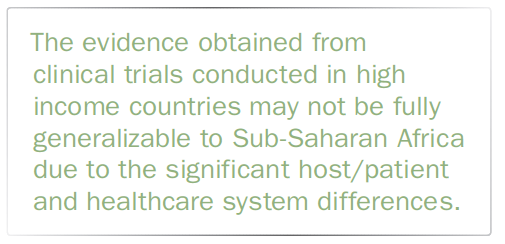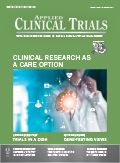Pediatric Oncology Clinical Trials in Sub-Saharan Africa
Applied Clinical Trials
The region is significantly underrepresented in clinical development activity targeting childhood cancer.

Despite contributing to pioneering work in childhood cancer, exemplified by the first description of Burkitt lymphoma nearly 50 years ago,1 Sub-Saharan Africa (SSA) has since lagged behind. In contrast to cure rates of more than 80% in high-income countries (HICs), in many parts of SSA, less than 20% of children with cancer are cured. With SSA bearing 30% of the global burden of childhood cancer, addressing this disparity in cure rates is critical.2 Enrollment in high-quality sequential clinical trials that are refining interventions over time has helped drive the success achieved against childhood cancer in HICs. To date, only two active childhood cancer clinical trials from SSA are registered.3
The Medline database contains only 13 childhood cancer publications from clinical trials in SSA, of which indigenous SSA senior authorship was less than 20%. Clearly, SSA is underrepresented in pediatric oncology clinical trial activity, and this may have a bearing on dismal childhood cancer outcomes in the region.
The need for childhood cancer-focused clinical trials in Sub-Saharan Africa
The need to improve outcomes of childhood cancer in SSA calls for the introduction of effective and safe interventions. Robust locally generated evidence does not exist for most cancer treatments in SSA.2 The evidence obtained from clinical trials conducted in HICs may not be fully generalizable to SSA due to the significant

host/patient and healthcare system differences between HICs and SSA.
Host: As a result of poor or delayed access to quality diagnostic services, children in SSA are more likely to be diagnosed at a more advanced stage of disease. There is also a higher prevalence of comorbidities such as malnutrition, HIV, and other tropical infections. Moreover, the ethnic differences between children in HICs and SSA may mean that they are not biologically comparable to allow generalizability of trial data from HICs to SSA.
Disease:Cancers such as Kaposi sarcoma and endemic Burkitt’s lymphoma are unique to SSA, and, therefore, of less interest to clinical research groups based in HICs. As such, researchers and clinicians in SSA must show leadership in developing evidence-based effective cancer interventions through clinical trials.
Health and social care infrastructure: Childhood cancer care provided in HICs is expensive and unaffordable for most countries in SSA. Furthermore, social security support systems for children with cancer are weak in SSA, resulting in increased household poverty and poor treatment compliance. The development of innovative low-cost, low-technology cancer therapies requiring minimal inpatient stay should be prioritized. The role of clinical trials in developing these interventions cannot be overstated.
The challenges of undertaking clinical trials in SSA
Medical researchers face many hurdles throughout the clinical trial process in SSA, including:
Lack of resources: Childhood cancer clinical trials are expensive to conduct and, inherently, unattractive to pharmaceutical companies. With public healthcare resources in SSA stretched to the limit, the scope for conducting clinical studies in SSA is also scarce. This challenge is compounded by a shortage of trained and experienced researchers in the area to perform trials.
Ethical concerns: Compared to HICs, SSA is often considered more “research friendly” because of its less stringent regulatory environment. However, this perceived convenience raises many concerns about the ethics of clinical trials in SSA, given the vulnerability of most research subjects in the region. Vulnerability to coercion may stem from actual or perceived lack of care options for subjects outside study settings. Furthermore, SSA has a shortage of personnel trained to provide ethical oversight through institutional review boards (IRBs), leading to a delay in IRB decisions.
Opportunities clinical trial protocols may deliver to SSA
Although the clinical trial landscape in SSA currently presents many challenges and questions, especially compared to studies performed in HICs, the research community is optimistic about the progress being made in SSA. Particularly in the childhood cancer research community, we expect to see a number of opportunities arise in this region, including:
Supporting clinical care: As has occurred in HICs, clinical trials in SSA could help to inform interventions that ease suffering and improve cure rates for children with cancer in the region. Studies may provide funding for care interventions and human resources in SSA, where competing clinical priorities abound despite constrained national health budgets.
Building research capacity: Clinical trials present a conduit through which the human and infrastructure resources for healthcare and research can be enhanced. Diagnostic equipment and other research project capital purchases often outlive the duration of individual clinical trials. The research and technical skills developed through training and active research participation by SSA staff widens the pool of local research talent.
Building collaborations: The disparity of skills and resources between HICs and SSA calls for healthcare and research partnerships between the two communities. The spectrum of diseases and challenges across SSA is fairly common; therefore, institutions need to work more closely together. For example, the development of research networks that can drive multicenter clinical trials would be beneficial to all parties.
Partnership with HICs can enable the transfer and exchange of research skills and mentorship of SSA-based researchers to lead the drive for improved outcomes for children with cancer in SSA. Patients in HICs stand to benefit from multinational clinical trials conducted across sites in SSA and HICs.
Notwithstanding the difficulties, the need for childhood cancer clinical trial activity in SSA to help provide better treatments for kids across the world is self-evident. The unmet need provides a unique opportunity for researchers and institutions in both HIC and low and middle-income countries (LMIC) to collaborate and develop innovative solutions that will positively impact childhood cancer outcomes within SSA and globally.
References
- Burkitt D. A Tumour Syndrome Affecting Children in Tropical Africa. Postgraduate Medical Journal. 1962; 38:71-79
- Jonas A. de Souza, Bijou Hunt, Fredrick Chite Asirwa, Clement Adebamowo, and Gilberto Lopes Global Health Equity: Cancer Care Outcome Disparities in High, Middle and Low-Income Countries. Journal of Clinical Oncology. 2016 34:1, 6-13
- Gopal S. Cancer trials in sub-Saharan Africa: Aligning research and care. PLoS Medicine. 2017;14(7):e1002351. doi:10.1371/journal.pmed.1002351.
Peter Wasswa, MD, is Assistant Professor of Pediatrics – Hematology and Oncology International at Baylor and Texas Children’s Cancer and Hematology Center. He is a St. Baldrick’s Foundation International Scholar.

Improving Relationships and Diversifying the Site Selection Process
April 17th 2025In this episode of the Applied Clinical Trials Podcast, Liz Beatty, co-founder and chief strategy officer, Inato, discusses a number of topics around site engagement including community-based sites, the role of technology in improving site/sponsor relationships, how increased operational costs are impacting the industry, and more.
Behind the Buzz: Why Clinical Research Leaders Flock to SCOPE Summit
February 7th 2025In this episode, we meet with Micah Lieberman, Executive Conference Director for SCOPE Summit (Summit for Clinical Ops Executives) at Cambridge Innovation Institute. We will dive deep into the critical role of collaboration within the clinical research ecosystem. How do we bring together diverse stakeholders—sponsors, CROs, clinical trial tech innovators, suppliers, patients, sites, advocacy organizations, investors, and non-profits—to share best practices in trial design, program planning, innovation, and clinical operations? We’ll explore why it’s vital for thought leaders to step beyond their own organizations and learn from others, exchanging ideas that drive advancements in clinical research. Additionally, we’ll discuss the pivotal role of scientific conferences like SCOPE Summit in fostering these essential connections and collaborations, helping shape the future of clinical trials. Join us as we uncover how collective wisdom and cross-industry partnerships are transforming the landscape of clinical research.
FDA-Approved Gene Therapy Beqvez Shows Sustained Efficacy, Safety in Long-Term Hemophilia B Trial
April 17th 2025Beqvez (fidanacogene elaparvovec), an FDA-approved one-time gene therapy for hemophilia B, demonstrated sustained factor IX expression, low bleeding rates, and a favorable safety profile over long-term follow-up.